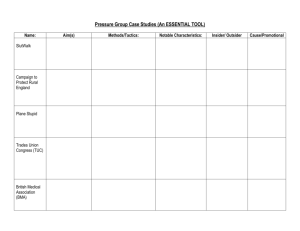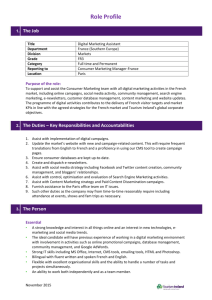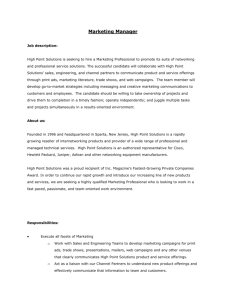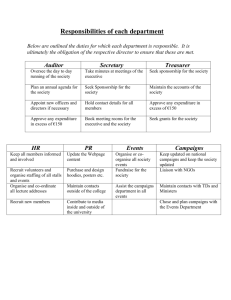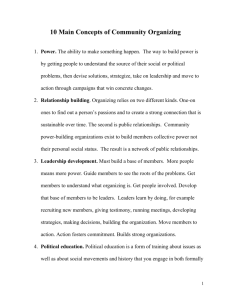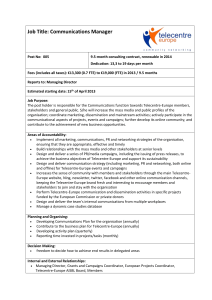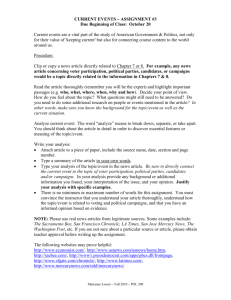Combination of Mass Media Health Campaigns and Health
advertisement
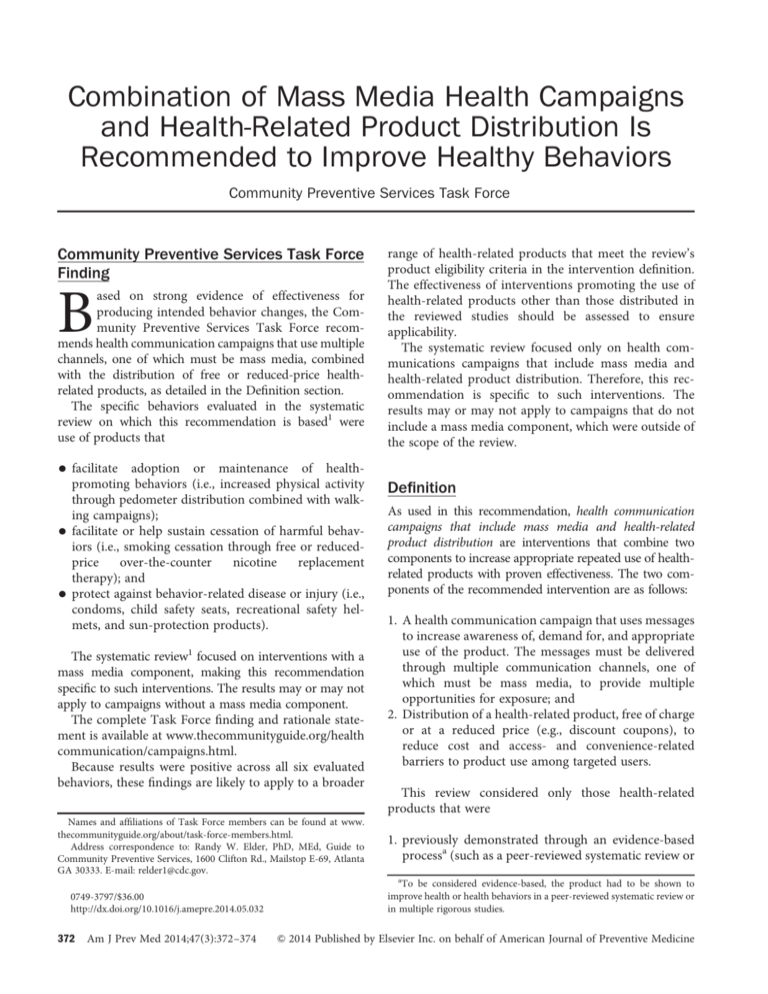
Combination of Mass Media Health Campaigns and Health-Related Product Distribution Is Recommended to Improve Healthy Behaviors Community Preventive Services Task Force Community Preventive Services Task Force Finding B ased on strong evidence of effectiveness for producing intended behavior changes, the Community Preventive Services Task Force recommends health communication campaigns that use multiple channels, one of which must be mass media, combined with the distribution of free or reduced-price healthrelated products, as detailed in the Definition section. The specific behaviors evaluated in the systematic review on which this recommendation is based1 were use of products that range of health-related products that meet the review’s product eligibility criteria in the intervention definition. The effectiveness of interventions promoting the use of health-related products other than those distributed in the reviewed studies should be assessed to ensure applicability. The systematic review focused only on health communications campaigns that include mass media and health-related product distribution. Therefore, this recommendation is specific to such interventions. The results may or may not apply to campaigns that do not include a mass media component, which were outside of the scope of the review. facilitate adoption or maintenance of health- promoting behaviors (i.e., increased physical activity through pedometer distribution combined with walking campaigns); facilitate or help sustain cessation of harmful behaviors (i.e., smoking cessation through free or reducedprice over-the-counter nicotine replacement therapy); and protect against behavior-related disease or injury (i.e., condoms, child safety seats, recreational safety helmets, and sun-protection products). The systematic review1 focused on interventions with a mass media component, making this recommendation specific to such interventions. The results may or may not apply to campaigns without a mass media component. The complete Task Force finding and rationale statement is available at www.thecommunityguide.org/health communication/campaigns.html. Because results were positive across all six evaluated behaviors, these findings are likely to apply to a broader Names and affiliations of Task Force members can be found at www. thecommunityguide.org/about/task-force-members.html. Address correspondence to: Randy W. Elder, PhD, MEd, Guide to Community Preventive Services, 1600 Clifton Rd., Mailstop E-69, Atlanta GA 30333. E-mail: relder1@cdc.gov. Definition As used in this recommendation, health communication campaigns that include mass media and health-related product distribution are interventions that combine two components to increase appropriate repeated use of healthrelated products with proven effectiveness. The two components of the recommended intervention are as follows: 1. A health communication campaign that uses messages to increase awareness of, demand for, and appropriate use of the product. The messages must be delivered through multiple communication channels, one of which must be mass media, to provide multiple opportunities for exposure; and 2. Distribution of a health-related product, free of charge or at a reduced price (e.g., discount coupons), to reduce cost and access- and convenience-related barriers to product use among targeted users. This review considered only those health-related products that were 1. previously demonstrated through an evidence-based processa (such as a peer-reviewed systematic review or a 0749-3797/$36.00 http://dx.doi.org/10.1016/j.amepre.2014.05.032 372 Am J Prev Med 2014;47(3):372–374 To be considered evidence-based, the product had to be shown to improve health or health behaviors in a peer-reviewed systematic review or in multiple rigorous studies. & 2014 Published by Elsevier Inc. on behalf of American Journal of Preventive Medicine Community Preventive Services Task Force / Am J Prev Med 2014;47(3):372–374 2. 3. 4. 5. 6. multiple rigorous studies) to improve health-related outcomes (e.g., increased physical activity, smoking cessation, and reductions in disease, injury, or death); tangible; not a service (e.g., mammogram); not exclusively available through prescription or administration by a health professional (e.g., vaccination or prescribed medication); used repeatedly or continually for desired health behavior change and disease and injury prevention effects (e.g., using condoms, wearing helmets) rather than a one-time behavior (e.g., installing smoke alarms); and not a food marketed as being “healthful” (e.g., oatmeal). Basis of Finding The Task Force finding is based on a systematic review1 (search period 1980–2009) with 25 study arms from 22 studies. Twenty study arms found that the intervention was associated with a median increase of 8.4 percentage points (interquartile interval [IQI]¼2.7, 14.5 percentage points) in the proportion of people engaging in a healthful behavior related to use of the distributed product. Similar results were found for five studies with results that could not be expressed as percentage point changes. The evidence also suggests that health campaigns that combine product distribution with a health communication campaign are more effective than health communication campaigns alone, without product distribution. The review considered six health-related products: child safety seats, condoms, pedometers, recreational safety helmets, over-the-counter nicotine replacement therapy, and sun-protection products. The most commonly evaluated interventions were those that promoted use of recreational safety helmets and condoms. Although the magnitude of intervention effects varied, favorable results were found for interventions promoting all evaluated products. Overall, results were consistently favorable across products with various characteristics (e.g., reusable versus single-use products; inherently protective products versus those that facilitate behavior change; those that promote the adoption of healthful new behaviors or the cessation of risky behaviors) and across a wide range of baseline usage rates. These results suggest that combining mass media health communication campaigns with distribution of any of a variety of health-related products that meet criteria specified in the review is likely to be effective in encouraging uptake of the intended health behaviors. Included communication campaigns used several different channels, always with mass media (e.g., TV, radio, newspapers) and nearly always including small September 2014 373 media (e.g., brochures, posters, fliers), over periods of time that ranged from 1 week to 36 months. In general, messages were disseminated via interpersonal communication (e.g., peer outreach, hotline numbers), community events (e.g., health fairs, festivals), and occasionally through social media (e.g., Facebook). Some campaigns were accompanied by other activities such as providing services (e.g., HIV testing, quitline counseling) or environmental changes (e.g., building walking trails). Results demonstrated effectiveness regardless of the number of distinct channels that disseminated the product-use message (e.g., mass media þ small media þ interpersonal communication, or mass media þ interpersonal communication). The available evidence suggests that interventions that were explicitly presented as social marketing campaigns had better results than those that did not. Results were generally consistent across interventions with different distribution sites (e.g., community organizations, retail stores). Applicability Across all evaluated campaigns, a wide variety of people were reached, including men, women, children, and people from diverse and varied racial and ethnic groups. Favorable results were found both for community-wide interventions and those targeted to specific demographic groups. These findings suggest that if campaigns and products are appropriately selected and targeted, they should be applicable across demographic groups. The goal of the review was to evaluate effectiveness of an intervention process—the combination of a health communication campaign that included mass media with health-related product distribution—for promoting desired behavior change in the target audience. To serve this goal, eligibility criteria defined a set of health-related products that, although unique, shared enough characteristics to allow generalizability of the review’s results to products with those characteristics. Thus, review findings may not generalize to health communication and distribution campaigns for products that do not meet eligibility criteria (e.g., intangible services or products that require one-time use or installation to promote or protect health/prevent injury). This does not imply that such interventions are ineffective, but simply that their effects cannot be assessed based on the studies evaluated in the review. Other Benefits and Harms Many campaigns had additional benefits, such as increasing other health behaviors and positively affecting 374 Community Preventive Services Task Force / Am J Prev Med 2014;47(3):372–374 populations not originally targeted by the campaign. No significant harms related to the included campaigns were found, which may be partly due to inclusion of messages about appropriate product use. Considerations for Implementation Campaigns were often large and complex. As a result, some authors reported barriers to implementation of the intervention, such as lack of community buy-in or failure of partners to meet their commitments (e.g., retailers charging for products that were intended for free distribution). The findings from The Community Guide review on which this recommendation is based1 are consistent with the existing body of research on health communication campaigns and extend it to improve understanding of the effectiveness of health communication campaigns combined with product distribution. Applying this finding to development of new health communication and social marketing campaigns and programs could play an important role in improving population health, as it relates to a wide variety of risk and protective factors. Evidence Gaps Only two campaigns disseminated their messages using Internet or social media channels. Researchers should take into account the assessment of effectiveness of product promotion and distribution interventions that use social media as a primary communication channel. In addition, when publishing research results, they should provide adequate detail about campaign design and execution, to help future research synthesis efforts as well as potential implementers. Reference 1. Robinson MN, Tansil KA, Elder RW, et al. Mass media health communication campaigns combined with health-related product distribution: a Community Guide systematic review. Am J Prev Med 2014;47(3):360–71. www.ajpmonline.org
